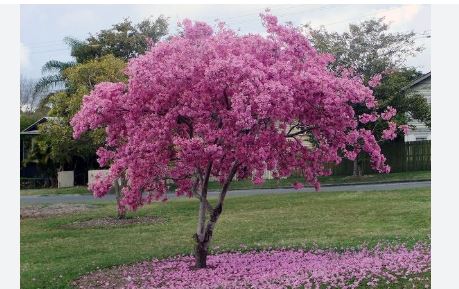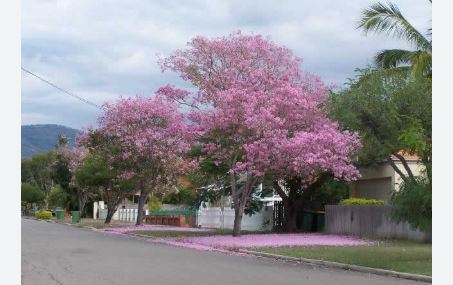
Botanical Classification
The Tabebuia tree, belonging to the genus Tabebuia in the Bignoniaceae family, encompasses approximately 100 species of flowering trees and shrubs, known for their trumpet-shaped flowers. The genus name Tabebuia derives from an indigenous Brazilian term, possibly from the Tupi language, meaning “ant wood,” referring to the tree’s hard, insect-resistant wood.
Notable species include Tabebuia rosea (Pink Trumpet Tree), Tabebuia chrysotricha (Golden Trumpet Tree), and Tabebuia impetiginosa (Purple Trumpet Tree). The Bignoniaceae family, which also includes jacaranda and catalpa, is characterized by showy, tubular flowers and pinnate or palmate leaves. Unlike Cassia fistula and Delonix regia (Fabaceae), Tabebuia species are not legumes and do not fix nitrogen, but their vibrant blooms make them a taxonomic standout in tropical and subtropical ornamental horticulture.
Native Area and Distribution
Tabebuia trees are native to Central and South America, with their natural range extending from Mexico and the Caribbean through Central America to Brazil, Argentina, and Paraguay. They thrive in diverse habitats, including tropical rainforests, dry forests, and savannas, often at elevations from sea level to 1,500 meters.
Species like Tabebuia rosea are common in Central American lowlands, while Tabebuia chrysotricha prefers drier, subtropical regions of Brazil. Due to their ornamental appeal, Tabebuia species have been widely introduced to tropical and subtropical regions worldwide, including Florida, Hawaii, India, Southeast Asia, Africa, and Australia. In some areas, such as parts of Florida and India, they have naturalized but are rarely invasive compared to species like Delonix regia. By 2025, Tabebuia trees are a staple in urban and rural landscapes globally, valued for their colorful blooms and adaptability to warm climates.
History

Tabebuia trees have a long history of cultural and practical significance in their native Americas. Indigenous peoples, such as the Tupi and Guarani, used the durable wood of species like Tabebuia impetiginosa (also called Pau d’Arco) for tools, construction, and medicinal purposes, with bark extracts traditionally used to treat infections and inflammation, though modern use requires caution due to potential toxicity.
The tree’s vibrant flowers earned it names like Trumpet Tree, Ipe, or Rosas Moradas in Spanish-speaking regions. European colonizers and botanists in the 18th and 19th centuries spread Tabebuia globally through botanical gardens and trade, particularly to tropical colonies in Asia and Africa. In Central America, Tabebuia rosea is the national tree of El Salvador, symbolizing beauty and resilience.
In India, species like Tabebuia avellanedae are celebrated in spring festivals for their pink and purple blooms, often planted alongside Cassia fistula and Delonix regia for colorful displays. By 2025, Tabebuia remains a cornerstone of tropical landscaping, featured in urban greening projects and eco-tourism sites for its aesthetic and ecological contributions.
USDA Zones
Tabebuia trees thrive in USDA Hardiness Zones 9b–11, preferring warm, tropical, and subtropical climates with minimal frost. Species like Tabebuia rosea and Tabebuia chrysotricha perform best in Zones 10–11, where temperatures rarely drop below 30°F (-1°C), such as in South Florida, Southern California, Hawaii, and parts of Arizona and Texas.
In Zone 9b, they may survive with protection (e.g., frost blankets or container planting), but prolonged cold below 25°F (-4°C) can damage or kill young trees. Tabebuia impetiginosa is slightly more cold-tolerant, surviving brief dips to 20°F (-6°C) with defoliation. In 2025, gardeners in cooler zones (e.g., 8b–9a) can grow Tabebuia in containers, moving them indoors or into greenhouses during winter, using smart climate-control systems to mimic tropical conditions.
Growth Rate
Tabebuia trees are moderately fast-growing, typically adding 2–4 feet per year under optimal conditions (full sun, well-drained soil, and adequate water). Seedlings can reach 8–12 feet within 2–3 years, with mature trees attaining heights of 20–50 feet (6–15 meters), depending on the species, within 10–15 years.
For example, Tabebuia rosea can grow to 80 feet in ideal tropical conditions but is typically 20–30 feet in cultivation, with a canopy spread of 15–25 feet. Tabebuia chrysotricha is smaller, often 15–25 feet tall. Growth is fastest in tropical climates with distinct wet and dry seasons, slowing in cooler or consistently humid conditions. Flowering generally begins 3–5 years after planting for seed-grown trees, with peak blooms in mature specimens.
Identifying Characteristics
- Size and Form: Tabebuia trees are deciduous or semi-evergreen, depending on the species and climate, growing to 20–50 feet tall (6–15 meters), with some like Tabebuia rosea reaching 80 feet in tropical settings. They typically have a rounded or spreading canopy, 15–25 feet wide, though smaller species like Tabebuia chrysotricha are more compact.
- Trunk and Bark: The trunk is slender, 1–2 feet in diameter, with smooth, greyish-brown bark that becomes fissured with age.
- Leaves: Pinnate or palmate, 6–12 inches long, with 5–7 elliptic or ovate leaflets (2–4 inches long), bright green, and sometimes pubescent (e.g., Tabebuia chrysotricha). Trees are briefly leafless during flowering, highlighting blooms.
- Flowers: The hallmark feature, appearing in spring (March–May in the Northern Hemisphere) in dense clusters. Flowers are trumpet-shaped, 2–4 inches long, in colors like pink (Tabebuia rosea), yellow (Tabebuia chrysotricha), or purple (Tabebuia impetiginosa), with five petals and a slightly flared throat. Blooms are profuse, creating a carpet of fallen petals.
- Fruit: Woody, cylindrical seedpods, 6–12 inches long, containing winged seeds that disperse by wind.
- Distinctive Traits: The vibrant, trumpet-like flowers and leafless flowering period make Tabebuia unmistakable, often likened to a “floral explosion” in landscapes.
Landscape Uses
Tabebuia trees are prized for their spectacular floral displays and versatility in tropical and subtropical landscapes.
- Specimen Tree: The vibrant pink, yellow, or purple blooms make Tabebuia a focal point in gardens, parks, or estates, especially during its leafless flowering phase.
- Shade Tree: The rounded canopy provides moderate shade, suitable for courtyards, patios, or small parks, though less expansive than Delonix regia.
- Street and Avenue Planting: Used along boulevards or medians in tropical cities (e.g., Miami, São Paulo), often alternated with Cassia fistula or Delonix regia for colorful sequences. Requires planting strips 4–6 feet wide to accommodate roots.
- Urban Landscaping: Ideal for parking lot islands (>100 sq ft) and tree lawns due to drought tolerance and compact size (especially Tabebuia chrysotricha).
- Biodiversity Support: Flowers attract bees, butterflies, and hummingbirds, enhancing local ecosystems. Seedpods draw seed-eating birds.
- Coastal Gardens: Tolerates moderate salt spray, making it suitable for coastal areas like South Florida or the Caribbean.
- Cultural Settings: Planted near landmarks or in festival grounds (e.g., in El Salvador) for symbolic beauty, especially Tabebuia rosea.
- Erosion Control: The root system stabilizes soil, useful for sloped landscapes or reclamation projects.
Cultivation
Cultivating Tabebuia requires attention to its tropical and subtropical preferences, but its moderate growth rate and adaptability make it rewarding for gardeners in suitable climates. Below are detailed guidelines:Site Selection
- Climate: Best in USDA Zones 9b–11, thriving in warm, humid summers and mild winters. Protect from frost in Zone 9b with blankets or container planting.
- Sunlight: Requires full sun (6–8 hours daily) for optimal growth and flowering. Avoid shaded areas, as insufficient light reduces blooms.
- Soil: Prefers well-drained soils, including sandy, loamy, or slightly alkaline soils (pH 5.5–7.5). Tolerates poor soils but not waterlogged conditions.
Propagation
- Seeds: The primary method. Seeds require scarification (soaking in warm water for 24 hours or abrading) to break dormancy. Sow in spring at 70–80°F (21–27°C). Germination takes 7–21 days, with seedlings transplantable after 6–12 months.
- Cuttings: Semi-hardwood cuttings can be used for faster flowering (2–3 years vs. 3–5 for seeds). Root in a well-draining medium with rooting hormone.
- Sourcing: Obtain seeds or saplings from reputable nurseries, ensuring species suitability for your climate (e.g., Tabebuia chrysotricha for smaller spaces).
Planting
- Spacing: Space trees 15–25 feet apart to accommodate canopy spread. Stake young trees to support against wind and promote straight growth.
- Method: Dig a hole twice as wide and as deep as the root ball. Mix soil with compost for nutrients. Plant at the same depth as the nursery pot, water thoroughly, and mulch with organic material to retain moisture.
- Container Planting: In cooler zones, grow in large pots (10–15 gallons) for mobility, moving indoors during winter.
Maintenance
- Watering: Water regularly during the first 1–2 years to establish roots (2–3 times weekly). Once established, Tabebuia is drought-tolerant, needing occasional deep watering in dry seasons. Avoid overwatering to prevent root rot.
- Fertilization: Apply a balanced fertilizer (e.g., 10-10-10) in spring and early summer to promote growth and flowering. Organic options like compost or fish emulsion enhance soil health.
- Pruning: Prune young trees after flowering to shape the canopy and remove low branches. Mature trees require minimal pruning, mainly to remove deadwood or maintain clearance (8–10 feet for streets). Prune in late summer to avoid bloom disruption.
- Pest and Disease Control: Generally pest-resistant but may face scale insects, aphids, or fungal leaf spots in humid conditions. Use neem oil or insecticidal soap for pests and ensure good air circulation to prevent fungi. Regular inspections help catch issues early.
- Debris Management: Rake fallen flowers and seedpods regularly, as they can be messy in urban settings or near walkways.
Growth and Flowering
- Growth Timeline: Reaches 8–12 feet in 2–3 years and 20–50 feet in 10–15 years, depending on species. Tabebuia rosea may reach 80 feet in tropical conditions, while Tabebuia chrysotricha stays compact at 15–25 feet.
- Flowering Season: Blooms in spring (March–May in the Northern Hemisphere), with vibrant pink, yellow, or purple flowers lasting 3–4 weeks. A dry season enhances bloom intensity.
- Challenges: Frost damage in Zone 9b can stunt growth or kill young trees. Weak branches may break in high winds, so avoid exposed sites. Monitor for self-seeding in warm climates to prevent unwanted spread.